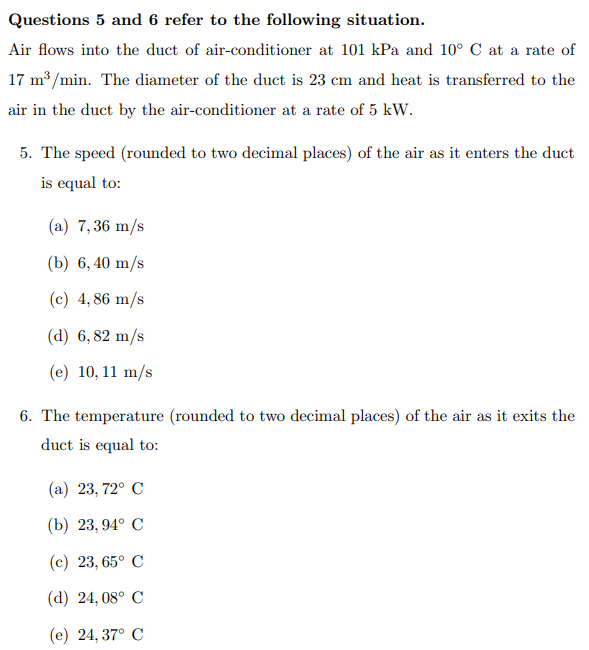Air flows into the duct of air-conditioner at 101 kPa and 10° C at a rate of 17 m³/min. The diameter of the duct is 23 cm and heat is transferred to the air in the duct by the air-conditioner at a rate of 5 kW. 5. The speed (rounded to two decimal places) of the air as it enters the duct is equal to: (a) 7,36 m/s (b) 6,40 m/s (c) 4,86 m/s (d) 6,82 m/s (e) 10, 11 m/s 6. The temperature (rounded to two decimal places) of the air as it exits the duct is equal to: (a) 23, 72° C (b) 23,94° C (c) 23,65° C (d) 24,08° C (e) 24,37° C
Air flows into the duct of air-conditioner at 101 kPa and 10° C at a rate of 17 m³/min. The diameter of the duct is 23 cm and heat is transferred to the air in the duct by the air-conditioner at a rate of 5 kW. 5. The speed (rounded to two decimal places) of the air as it enters the duct is equal to: (a) 7,36 m/s (b) 6,40 m/s (c) 4,86 m/s (d) 6,82 m/s (e) 10, 11 m/s 6. The temperature (rounded to two decimal places) of the air as it exits the duct is equal to: (a) 23, 72° C (b) 23,94° C (c) 23,65° C (d) 24,08° C (e) 24,37° C
Elements Of Electromagnetics
7th Edition
ISBN:9780190698614
Author:Sadiku, Matthew N. O.
Publisher:Sadiku, Matthew N. O.
ChapterMA: Math Assessment
Section: Chapter Questions
Problem 1.1MA
Related questions
Question
100%
Need solution to question 6 only within 20 minutes (answer of question 5 is 6.82m/s)

Transcribed Image Text:Questions 5 and 6 refer to the following situation.
Air flows into the duct of air-conditioner at 101 kPa and 10° C at a rate of
17 m³/min. The diameter of the duct is 23 cm and heat is transferred to the
air in the duct by the air-conditioner at a rate of 5 kW.
5. The speed (rounded to two decimal places) of the air as it enters the duct
is equal to:
(a) 7,36 m/s
(b) 6,40 m/s
(c) 4,86 m/s
(d) 6,82 m/s
(e) 10, 11 m/s
6. The temperature (rounded to two decimal places) of the air as it exits the
duct is equal to:
(a) 23, 72° C
(b) 23,94° C
(c) 23,65° C
(d) 24,08° C
(e) 24,37° C
Expert Solution
This question has been solved!
Explore an expertly crafted, step-by-step solution for a thorough understanding of key concepts.
Step by step
Solved in 2 steps

Knowledge Booster
Learn more about
Need a deep-dive on the concept behind this application? Look no further. Learn more about this topic, mechanical-engineering and related others by exploring similar questions and additional content below.Recommended textbooks for you

Elements Of Electromagnetics
Mechanical Engineering
ISBN:
9780190698614
Author:
Sadiku, Matthew N. O.
Publisher:
Oxford University Press

Mechanics of Materials (10th Edition)
Mechanical Engineering
ISBN:
9780134319650
Author:
Russell C. Hibbeler
Publisher:
PEARSON

Thermodynamics: An Engineering Approach
Mechanical Engineering
ISBN:
9781259822674
Author:
Yunus A. Cengel Dr., Michael A. Boles
Publisher:
McGraw-Hill Education

Elements Of Electromagnetics
Mechanical Engineering
ISBN:
9780190698614
Author:
Sadiku, Matthew N. O.
Publisher:
Oxford University Press

Mechanics of Materials (10th Edition)
Mechanical Engineering
ISBN:
9780134319650
Author:
Russell C. Hibbeler
Publisher:
PEARSON

Thermodynamics: An Engineering Approach
Mechanical Engineering
ISBN:
9781259822674
Author:
Yunus A. Cengel Dr., Michael A. Boles
Publisher:
McGraw-Hill Education

Control Systems Engineering
Mechanical Engineering
ISBN:
9781118170519
Author:
Norman S. Nise
Publisher:
WILEY

Mechanics of Materials (MindTap Course List)
Mechanical Engineering
ISBN:
9781337093347
Author:
Barry J. Goodno, James M. Gere
Publisher:
Cengage Learning

Engineering Mechanics: Statics
Mechanical Engineering
ISBN:
9781118807330
Author:
James L. Meriam, L. G. Kraige, J. N. Bolton
Publisher:
WILEY